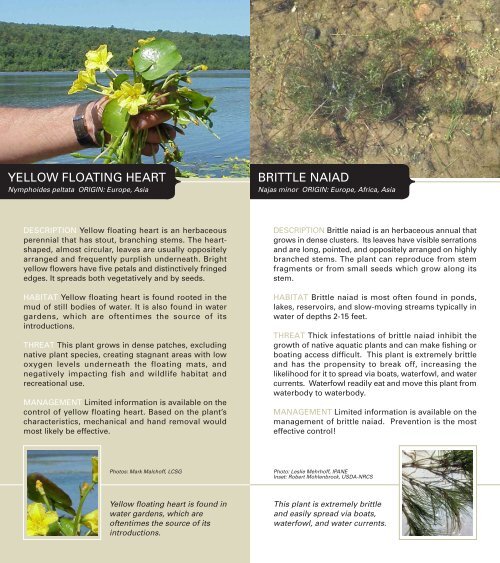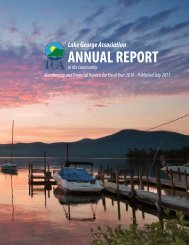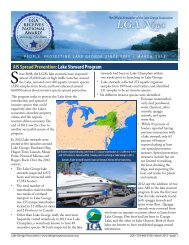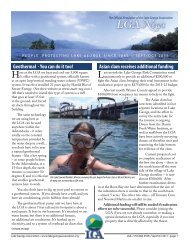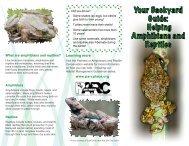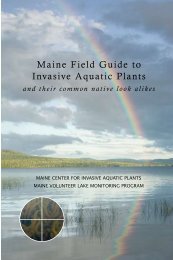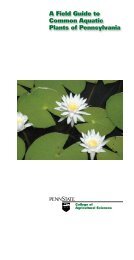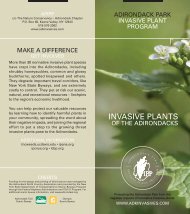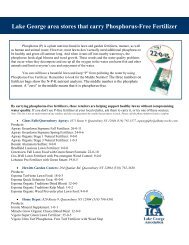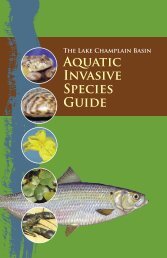Invasive Plants of the Adirondacks - Adirondack Park Invasive Plant ...
Invasive Plants of the Adirondacks - Adirondack Park Invasive Plant ...
Invasive Plants of the Adirondacks - Adirondack Park Invasive Plant ...
Create successful ePaper yourself
Turn your PDF publications into a flip-book with our unique Google optimized e-Paper software.
YELLOW FLOATING HEART<br />
Nymphoides peltata ORIGIN: Europe, Asia<br />
BRITTLE NAIAD<br />
Najas minor ORIGIN: Europe, Africa, Asia<br />
DESCRIPTION Yellow floating heart is an herbaceous<br />
perennial that has stout, branching stems. The heartshaped,<br />
almost circular, leaves are usually oppositely<br />
arranged and frequently purplish underneath. Bright<br />
yellow flowers have five petals and distinctively fringed<br />
edges. It spreads both vegetatively and by seeds.<br />
HABITAT Yellow floating heart is found rooted in <strong>the</strong><br />
mud <strong>of</strong> still bodies <strong>of</strong> water. It is also found in water<br />
gardens, which are <strong>of</strong>tentimes <strong>the</strong> source <strong>of</strong> its<br />
introductions.<br />
THREAT This plant grows in dense patches, excluding<br />
native plant species, creating stagnant areas with low<br />
oxygen levels underneath <strong>the</strong> floating mats, and<br />
negatively impacting fish and wildlife habitat and<br />
recreational use.<br />
MANAGEMENT Limited information is available on <strong>the</strong><br />
control <strong>of</strong> yellow floating heart. Based on <strong>the</strong> plant’s<br />
characteristics, mechanical and hand removal would<br />
most likely be effective.<br />
DESCRIPTION Brittle naiad is an herbaceous annual that<br />
grows in dense clusters. Its leaves have visible serrations<br />
and are long, pointed, and oppositely arranged on highly<br />
branched stems. The plant can reproduce from stem<br />
fragments or from small seeds which grow along its<br />
stem.<br />
HABITAT Brittle naiad is most <strong>of</strong>ten found in ponds,<br />
lakes, reservoirs, and slow-moving streams typically in<br />
water <strong>of</strong> depths 2-15 feet.<br />
THREAT Thick infestations <strong>of</strong> brittle naiad inhibit <strong>the</strong><br />
growth <strong>of</strong> native aquatic plants and can make fishing or<br />
boating access difficult. This plant is extremely brittle<br />
and has <strong>the</strong> propensity to break <strong>of</strong>f, increasing <strong>the</strong><br />
likelihood for it to spread via boats, waterfowl, and water<br />
currents. Waterfowl readily eat and move this plant from<br />
waterbody to waterbody.<br />
MANAGEMENT Limited information is available on <strong>the</strong><br />
management <strong>of</strong> brittle naiad. Prevention is <strong>the</strong> most<br />
effective control!<br />
Photos: Mark Malch<strong>of</strong>f, LCSG<br />
Photo: Leslie Mehrh<strong>of</strong>f, IPANE<br />
Inset: Robert Mohlenbrock, USDA-NRCS<br />
Yellow floating heart is found in<br />
water gardens, which are<br />
<strong>of</strong>tentimes <strong>the</strong> source <strong>of</strong> its<br />
introductions.<br />
This plant is extremely brittle<br />
and easily spread via boats,<br />
waterfowl, and water currents.


